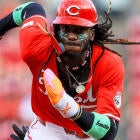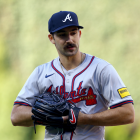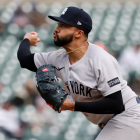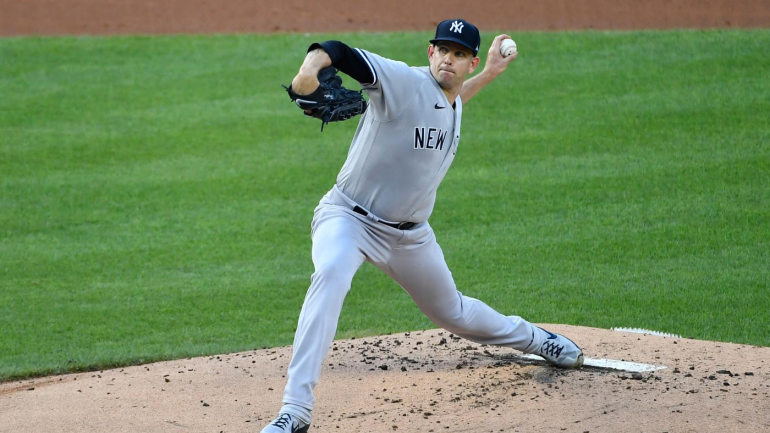
Saturday night at Nationals Park, the Washington Nationals and New York Yankees finally continued their season opening series. The two clubs opened the 2020 season Thursday evening with a rain-shortened affair and did not play again until Saturday night. The Giants and Dodgers played three full games between Game 1 and Game 2 of the Yankees-Nationals series, but I digress.
The defending World Series champions roughed up Yankees starter James Paxton and various relievers en route to their first win of the new season (WAS 9, NYY 2). Asdrubal Cabrera, who is stepping in at third base to replace Anthony Rendon, went 3 for 4 with a home run. Paxton completed only one inning and exited with the bases loaded and no outs in the second.
"I am not happy with it. Not how I wanted to start the season," Paxton said during a conference call after the game. "That being said, I have to put this one behind me and focus on what is next."
Good pitchers have bad starts and when bad starts happen early in the season, they tend to get magnified. Paxton was outstanding down the stretch last season, pitching to a 2.51 ERA with a .177/.248/.298 opponent's batting line in his final 11 starts, but Paxton looked nothing like that guy on Saturday night. It wasn't just a bad start. He looked little like himself.
"I didn't feel great," Paxton added. "I didn't really have the good fastball. Didn't really have a breaking ball to put guys away with. I was able to get to two strikes on some guys but just couldn't make pitches to put them away. It was just not a good night for me."
Paxton has been among the hardest throwers in baseball since making his debut in 2013 but his trademark velocity was nowhere to be found Saturday. After averaging 95.7 mph with his fastball last year, Paxton did not throw a pitch above 92.1 mph against the Nationals. His fastball averaged 92.0 mph Saturday night. A scary graph, this is:
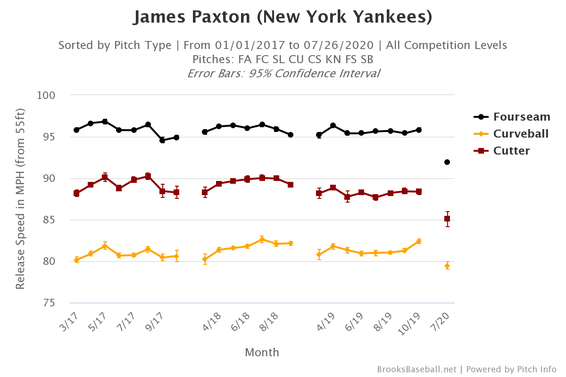
"I just felt a little sluggish tonight and my arm didn't feel like it was really live," Paxton said when asked about the missing velocity.
Furthermore, Paxton's release point was approximately six inches lower Saturday night than it was last season. Six inches is pretty significant. A lower release point equals a lower arm slot and is an indication his mechanics are not right. Here is an overlay GIF comparing Paxton's arm slot last season to Saturday night:
Not the first to mention this, as I've seen it referenced by @mikeaxisa and @mr_bobloblaw among others. But the difference in Paxton's release point is stark. This is a first-inning fastball from last night against a first-inning fastball from August 7th. pic.twitter.com/PNNvF6CNiX
— Lucas A (@DBITLefty) July 26, 2020
Paxton had back surgery in February and would have opened the season on the injured list had the season started on time. The surgery was a "microscopic lumbar discectomy," which is a fancy way of saying he had a herniated disc repaired and a peridiscal cyst removed. The surgery came with a 3-4 month recovery and Paxton was able to begin throwing on schedule in May.
"I think I've thrown probably 12-14 bullpens. My back is feeling really good. My back is a non-issue," Paxton told the YES Network on May 22. "... The velocity is getting better and better, breaking balls and stuff like that. Getting a feel for my pitches, so everything is going really well. I've seen some good results there."
Clearly, the velocity is not all the way back yet, and the fact Paxton has been throwing for over two months now and it still hasn't come all the way back is a red flag. The arm strength should be close to normal by now, especially since Paxton was stretched out to over 70 pitches and five innings during summer camp. It's not like he picked up a ball for the first time on Day 1 of camp.
Two weeks ago Paxton said his velocity was not back yet -- "It will be good to see when I'm in the mid-to-high 90s. That would show me I'm 100 percent back," he said during a July 10 conference call -- and added he was having trouble getting "full extension" on his pitches. Yankees manager Aaron Boone confirmed the lefty was having mechanical problems in summer camp.
The release point data is evidence of those mechanical issues and the missing velocity is a result. It's entirely possible Paxton's velocity will return when he locks in his mechanics, but, with back surgery in his recent past, it's fair to wonder how long it will take him to find his mechanics, and whether he can find them at all. He may need to develop new mechanics and adjust to his new body.
Velocity is not everything, of course, but it's not nothing either, and there's a significant difference between averaging 92 mph and averaging close to 96 mph. The more velocity you have, the less time the hitter has to react. It really is that simple. Here is the league-wide data at different fastball velocity ranges in 2019:
| Batting average | Slugging percentage | Swing and miss rate | |
|---|---|---|---|
90 mph or less | .280 | .495 | 19.8 percent |
91-93 mph | .291 | .512 | 18.4 percent |
94-96 mph | .259 | .444 | 21.7 percent |
97-99 mph | .242 | .389 | 25.3 percent |
100+ mph | .189 | .293 | 25.4 percent |
The good news is Paxton, an impending free agent with quite a bit on the line this season, says he is pain free and his back is a non-issue. "There's no pain at all in throwing," he said Saturday night. The bad news is Paxton is now six months out from surgery and three months into throwing program, and he still doesn't look like himself. Not even close, really.
"I'm not alarmed. I feel like physically, he is sound," the perpetually optimistic Boone said during a conference call Saturday night. "I think it's just a matter of really getting his delivery and finding that click where he's really extending through the ball. That's kind of what he's been searching for here these last few weeks."
The Yankees will be without Luis Severino (Tommy John surgery) and Domingo German (domestic violence suspension) all season, though they are expected to get Masahiro Tanaka back next week after he took a line drive to the head early in summer camp, and their rotation depth is solid. Jonathan Loaisiga, Michael King, and prospects Deivi Garcia and Clarke Schmidt are fine 6-9 starter options.
Paxton is not a depth starter for the Yankees, however. The Yankees are a World Series contender and the master plan is Paxton as the No. 2 starter behind Gerrit Cole in the postseason. At worse, they want him to be their No. 3 behind Cole and Tanaka. When he's right, Paxton can be that guy. Clearly though, he's not right, and the longer it takes him to get right, the bigger a problem it will be for the Yankees.
"I think it will come with time, but it's definitely something that I want to address and look at going forward," Paxton said about his missing velocity and improper mechanics.
![[object Object] Logo](https://sportshub.cbsistatic.com/i/2020/04/22/e9ceb731-8b3f-4c60-98fe-090ab66a2997/screen-shot-2020-04-22-at-11-04-56-am.png)













